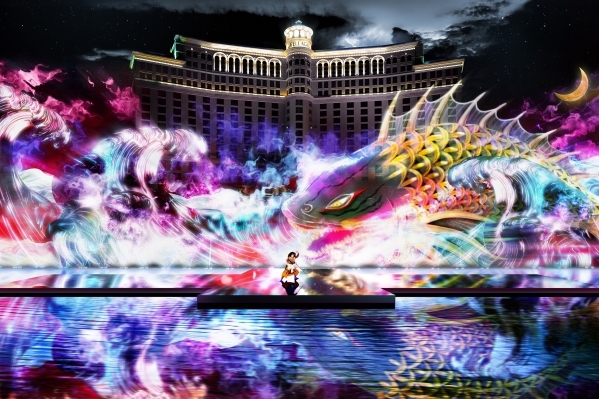Traditional Japanese theater goes high-tech with Bellagio fountain show

The Japanese art of kabuki has endured for more than four centuries without so much as a glint of Vegas glitz.
Until now.
This weekend, Bellagio’s signature fountains host — and play a role in — a free 30-minute spectacle adapted from the kabuki classic “Koi Tsukami (Fight With a Carp).”
It’s free, to the public, that is, with performances at 9:15 p.m. Friday and 9:15 and 11:30 p.m. Saturday and Sunday. But the high-tech production “obviously is going to involve millions of dollars,” says Alan Feldman, executive vice president of MGM Resorts, who describes the project as “incredibly ambitious.”
Some might say it’s also incredibly unexpected.
After all, using Bellagio’s Italian-inspired lake for a spectacle based on traditional Japanese theater represents an unusual multicultural mix, Feldman acknowledges.
“I think that’s a big part of what makes this so exciting,” he says. “It provides an artistic challenge for everyone involved.”
Although kabuki “is a traditional theatrical performance with a 412-year history,” like opera “it has reflected the times and has created new performances,” says Tetsuya Okazaki, managing director of Shochiku Co. Ltd., which operates Tokyo’s principal kabuki theater — and one of Japan’s movie studios.
With its elaborate costumes, rhythmic dialogue, music, dance and stylized acting, traditional kabuki pieces “were cutting-edge” when first performed, Okazaki says in an email interview.
And the “Koi Tsukami” spectacle at Bellagio definitely represents cutting-edge technology, with a specially built revolving stage, digital projection and computer-programmed fountain choreography uniting “new techniques and technology,” Okazaki says.
Those new techniques include choreographing Bellagio’s fountains, “almost moment by moment,” to “the movement onstage,” says Peter Kopik, associate designer and director of choreography for Southern California-based WET, which designed the fountains.
(They’re the largest in the U.S., with more than a thousand air-pressure cannons and 200-plus underwater robots making the fountains dance.)
Amid the dancing fountains and giant projections, however, will be actor Ichikawa Somegoro, the latest in a multigenerational line of kabuki actors.
“I was born in a house where kabuki was present,” Somegoro says in an email interview, but “I didn’t become a kabuki actor because I was born in a kabuki actor’s household. Rather, I believe I was given life in this world to become a kabuki actor.”
During this weekend’s performances, Somegoro will portray a young samurai who finds love with a beautiful princess (who, in kabuki tradition, is played by actor Nakamura Yonekichi).
The two will glide in a boat across Bellagio’s lake, landing at the specially constructed stage, where they’ll dance, sharing the glories of spring, summer and fall.
That is, until the samurai glances at his beloved’s shadow and realizes she’s actually a carp, transformed into human form to avenge the death of her fiance.
She then metamorphoses into a gigantic, monstrous fish, thanks to larger-than-life animations from Japan’s teamLab, forcing Somegoro’s samurai to fight for his life as turbulent waters erupt around him.
“In the end, the spirit of the carp is defeated, communicating the typical Japanese story of encouraging good and punishing evil,” the actor says.
Overall, the tale “incorporates an abundance of kabuki characteristics,” Somegoro adds, “and having a tachimawari (fight scene) with actual water allows us to present the acrobatic aspect of kabuki.”
For Kopik and associate Bonnie Thompson, achieving that acrobatic aspect meant a three-month process — including multiple Skype consultations with their Japanese colleagues.
Normally, “we don’t like to use water as a character,” Kopik says. But “here, we have to be very deliberate,” with water “symbolizing characters.”
For example, they were “asked to show a drunken fighter carrying a large fish,” Kopik says, which required “certain undulating movements” that could be “dramatic but also funny.”
Initially, Kopik “was wondering how the hell I’m going to pull this off,” he adds.
But WET managed to “find a common ground” and “we were able to create a show that’s both pleasing for the creators and understandable for Western audiences.”
Bringing kabuki to a wider world is a priority for Shochiku, whose officials are “interested in exploring how to reach new audiences and extend this amazing art form,” Feldman says. (In February, the company announced another project designed to present “to the world Japan’s traditional culture in the form of modern pop culture through kabuki and clothes,” Shochiku’s website says.)
A Japanese television documentary will not only bring the Bellagio spectacle to viewers in kabuki’s home country but introduce Japanese viewers to 21st-century Las Vegas, Feldman says.
“For most Japanese, their view of Las Vegas” centers on “black-and-white photography of the ’60s,” Las Vegas’ Rat Pack era, he asserts. “It’s an enormous audience — the third-largest economy in the world” with “an enormous audience of potential new travelers.”
As for the thousands of spectators on the Strip, they’ll have the chance to sample an art form that may return to Las Vegas. (At least that was what Shochiku and MGM officials announced in May, promising to follow this weekend’s spectacle with a full-fledged kabuki festival next year.)
“Kabuki is always faced with a sense of crisis in order to survive as a theatrical performance,” Somegoro says, “so it is always on new endeavors and is always evolving.”
For more stories from Carol Cling go to bestoflasvegas.com. Contact her at ccling@reviewjournal.com and follow @CarolSCling on Twitter.